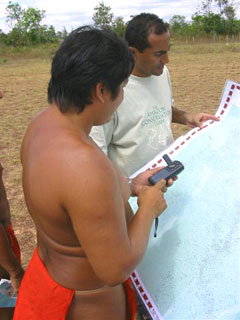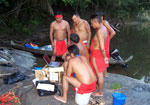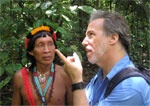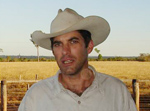Google helps protect Amazon rainforest
Google helps protect Amazon rainforest
Rhett A. Butler, mongabay.com
June 10, 2007
Google is working with an indigenous tribe deep in the Amazon rainforest to protect their native lands from illegal encroachment, reports the San Francisco Chronicle.
For the first time, Google has confirmed details of the project.
“The Amazon rain forest and its indigenous peoples are disappearing rapidly, which has serious consequences both locally and globally,” Google Earth spokeswoman Megan Quinn told the San Francisco Chronicle. “This project can raise global awareness of the Surui people’s struggle to preserve their land and culture by reaching more than 200 million Google Earth users around the world.”
Working in conjuction with the Amazon Conservation Team, Google Earth’s technology is being used to monitor illegal mining and logging that threaten the lands of the Surui tribe in Brazil. Google is working with satellite providers to significantly improve image resolution in some of the most remote parts of the Amazon basin.
“We made a presentation earlier this year explaining how we use the images,” said Vasco van Roosmalen, the Amazon Conservation Team’s Brazil program director, in an interview with mongabay.com. “We offered the Google Earth team a list of coordinates where it would be helpful to have sharper images. We also discussed the possibility of finding ways to include the Indians’ nonproprietary data, as a layer with Indian names, on Google Earth.”
 GPS mapping of Tumucumaque in Brazil. Image courtesy of Amazon Conservation Team. |
“Google Earth is used primarily for vigilance. Indians log on to Google Earth and study images, inch by inch, looking to see where new gold mines are popping up or where invasions are occurring,” he continued. “With the newly updated, high-resolution images of the region, they can see river discoloration which could be the product of sedimentation and pollution from a nearby mine. They are able to use these images to find the smallest gold mine.”
“We are starting with Chief Almir [Chief Almir Surui is the leader of the Surui tribe in northeastern Brazil]… because his tribe is the most advanced in their mapping skills and in their vision for positive use of technology,” the San Francisco Chronicle quoted Google Earth’s Quinn as saying. “We hope this project will inspire other Amazon tribes.”
Google Earth has also worked with the Jane Goodall Institute to track chimpanzees in Tanzania and other groups in the Amazon to monitor deforestation.
Earlier coverage
 |
Amazon Indians use Google Earth, GPS to protect forest home
(11/14/2006) Deep in the most remote jungles of South America, Amazon Indians are using Google Earth, Global Positioning System (GPS) mapping, and other technologies to protect their fast-dwindling home. Tribes in Suriname, Brazil, and Colombia are combining their traditional knowledge of the rainforest with Western technology to conserve forests and maintain ties to their history and cultural traditions, which include profound knowledge of the forest ecosystem and medicinal plants. Helping them is the Amazon Conservation Team (ACT), a nonprofit organization working with indigenous people to conserve biodiversity, health, and culture in South American rainforests.
 |
Indians are key to rainforest conservation efforts says renowned ethnobotanist
(10/31/2006) Tropical rainforests house hundreds of thousands of species of plants, many of which hold promise for their compounds which can be used to ward off pests and fight human disease. No one understands the secrets of these plants better than indigenous shamans -medicine men and women – who have developed boundless knowledge of this library of flora for curing everything from foot rot to diabetes. But like the forests themselves, the knowledge of these botanical wizards is fast-disappearing due to deforestation and profound cultural transformation among younger generations. The combined loss of this knowledge and these forests irreplaceably impoverishes the world of cultural and biological diversity. Dr. Mark Plotkin, President of the non-profit Amazon Conservation Team, is working to stop this fate by partnering with indigenous people to conserve biodiversity, health, and culture in South American rainforests. Plotkin, a renowned ethnobotanist and accomplished author (Tales of a Shaman's Apprentice, Medicine Quest) who was named one of Time Magazine's environmental "Hero for the Planet," has spent parts of the past 25 years living and working with shamans in Latin America. Through his experiences, Plotkin has concluded that conservation and the well-being of indigenous people are intrinsically linked — in forests inhabited by indigenous populations, you can’t have one without the other. Plotkin believes that existing conservation initiatives would be better-served by having more integration between indigenous populations and other forest preservation efforts.
Also related
 |
Cattle ranchers and soy farmers could save the Amazon
(06/07/2007) John Cain Carter, a Texas rancher who moved to the the Brazilian state of Mato Grosso 11 years ago and founded what is perhaps the most innovative organization working in the Amazon, Aliança da Terra, believes the only way to save the Amazon is through the market. Carter says that by giving producers incentives to reduce their impact on the forest, the market can succeed where conservation efforts have failed. What is most remarkable about Aliança’s system is that it has the potential to be applied to any commodity anywhere in the world. That means palm oil in Borneo could be certified just as easily as sugar cane in Brazil or sheep in New Zealand. By addressing the supply chain, tracing agricultural products back to the specific fields where they were produced, the system offers perhaps the best market-based solution to combating deforestation. Combining these approaches with large-scale land conservation and scientific research offers what may be the best hope for saving the Amazon.














